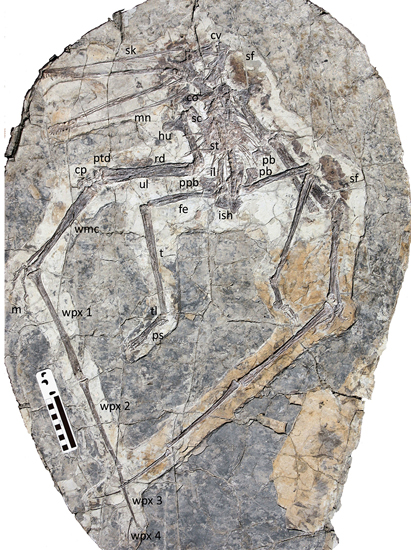Luchibang xingzhe – Long-legged Chinese Pterosaur Described
A team of international scientists including Dr David Hone (Queen Mary University of London) and colleagues from the University of Wisconsin-Madison, the China University of Geosciences and the Institute of Vertebrate Palaeontology and Palaeoanthropology (Beijing), have published a paper describing a new species of long-legged pterosaur that once flew over the skies of what is now Inner Mongolia. The new flying reptile has been named Luchibang xingzhe (pronounced Loo-chee-bang shing-hey).
The Nearly Complete Holotype Specimen of Luchibang xingzhe

Picture credit: Palaeontologia Electronica
Described from a Single Specimen
Described from a single, near complete, articulated specimen (ELDM 1000), this pterosaur has been assigned to the Istiodactylidae family, members of the Suborder Pterodactyloidea, known for their short-tails, long toe bones and very thin walls to their bones. Istiodactylid pterosaurs were geographically widespread, fossils having been found in Lower Cretaceous sediments located in North America, the Isle of Wight (southern England) and northern China.
Although the animal was immature when it died, it already had a wingspan estimated at around two metres. The fossil skeleton indicates that it was already much bigger than most other istiodactylids, suggesting a large wingspan (perhaps around five metres), as an adult. Luchibang had proportionately long hindlimbs and these, plus the teeth, suggest that this flying reptile hunted fish, perhaps stalking them in the same way as a modern heron.
The pterosaur has been named in honour of Lü Junchang, (Chinese Academy of Geological Sciences), in recognition of his research work on Chinese members of the Pterosauria and from the Mandarin word for “heron”.
Luchibang xingzhe with Robust and Elongated Hindlimbs
The fossil specimen is the most complete istiodactylid specimen described to date. The completeness of the skeleton was one of the factors that led to allegations that the fossil had been faked. Sadly, many fossils from China are “enhanced” to make them more valuable. However, after extensive analysis the specimen has been proved to be genuine, but this issue along with a debate with regards to phylogeny led to delays in publication.
It is to the credit of the research team that they persevered and that the scientific paper has now been published. Intriguingly, the fossilised remains of two small fish (probably Lycoptera), are preserved in association with Luchibang. One fish resides between the jaws (see photograph below), whilst the second is inside the rib cage and may represent the remains of this flying reptile’s last meal. If the second fish fossil does represent gut contents, then this reinforces the idea that Luchibang was a piscivore (fish-eater).
A Close View of the Partial Skull and the Jaws of Luchibang xingzhe With Fish Remains in Association

Picture credit: Palaeontologia Electronica
The scientific paper: “An unusual new genus of istiodactylid pterosaur from China based on a complete specimen” by David W. E. Hone, Adam J. Fitch, Feimin Ma and Xing Xu published in Palaeontologia Electronica.
The Everything Dinosaur website: Everything Dinosaur.






Leave A Comment